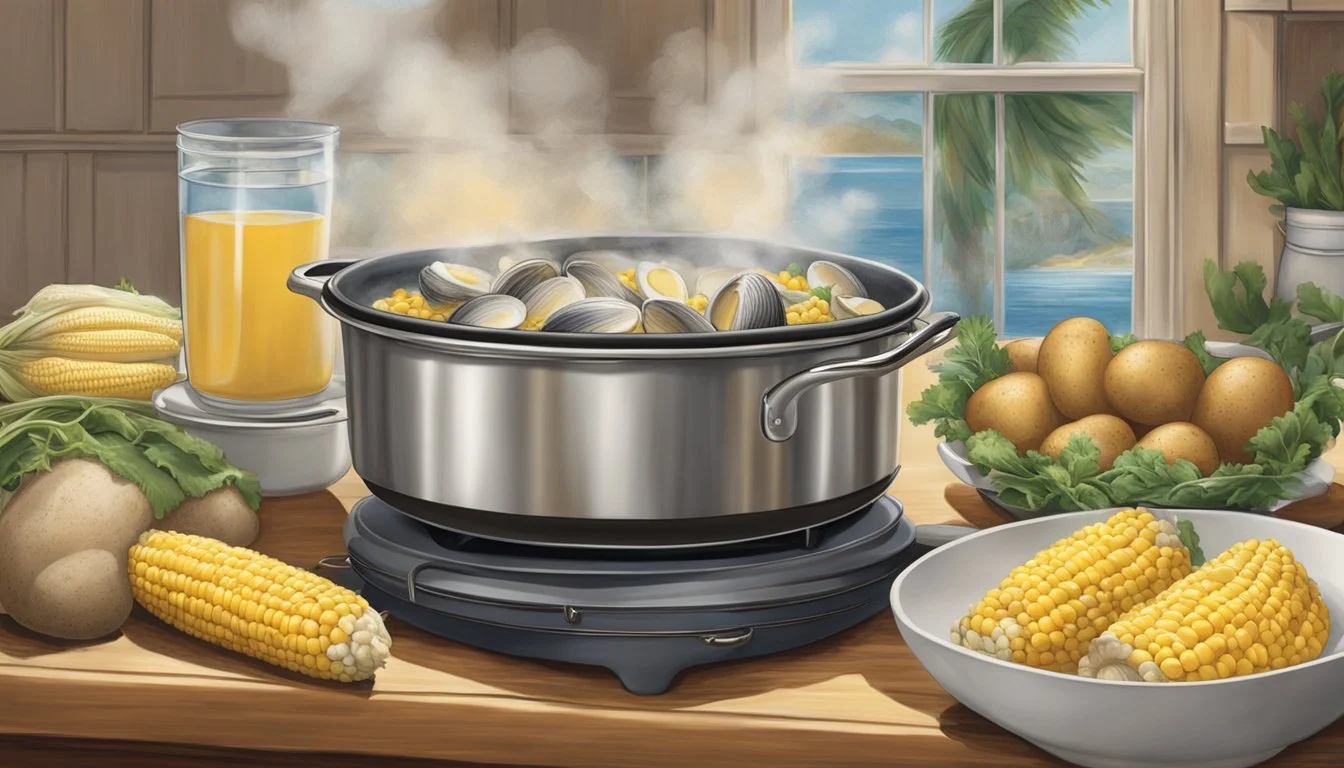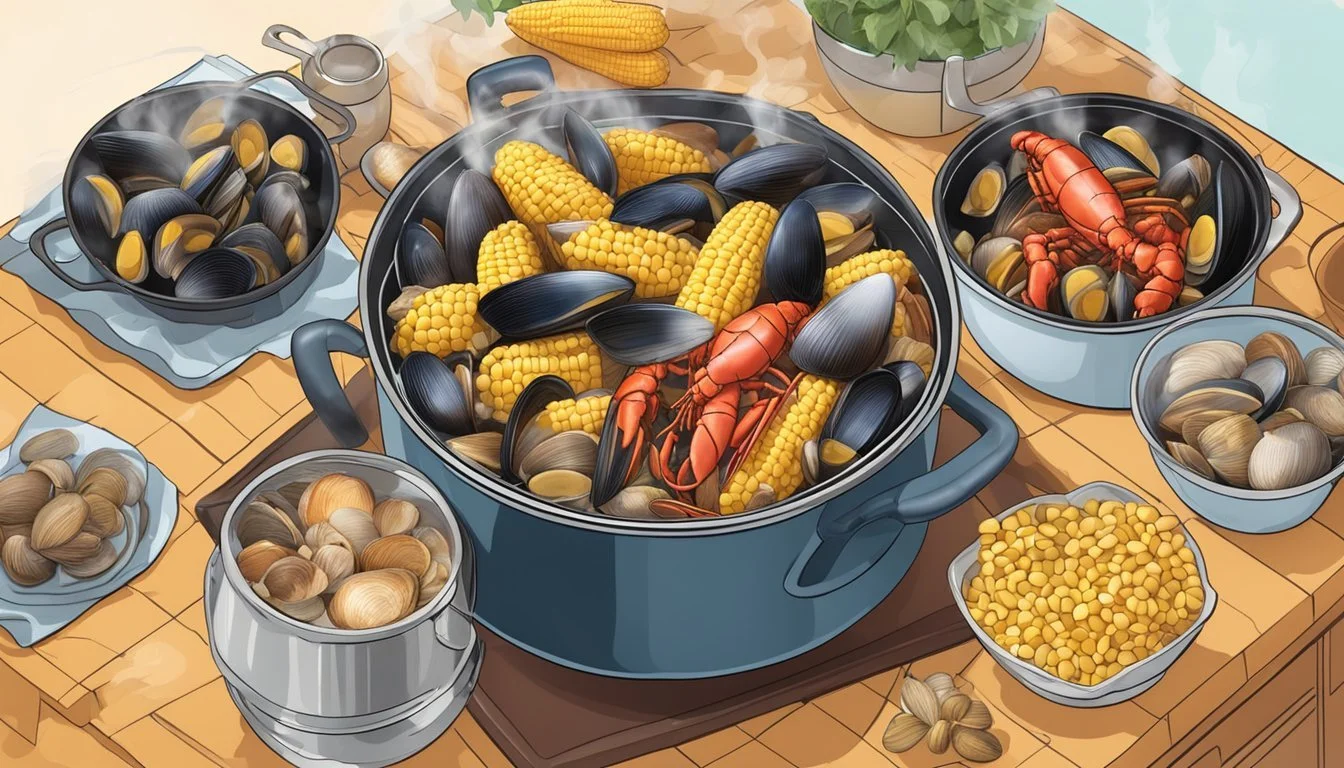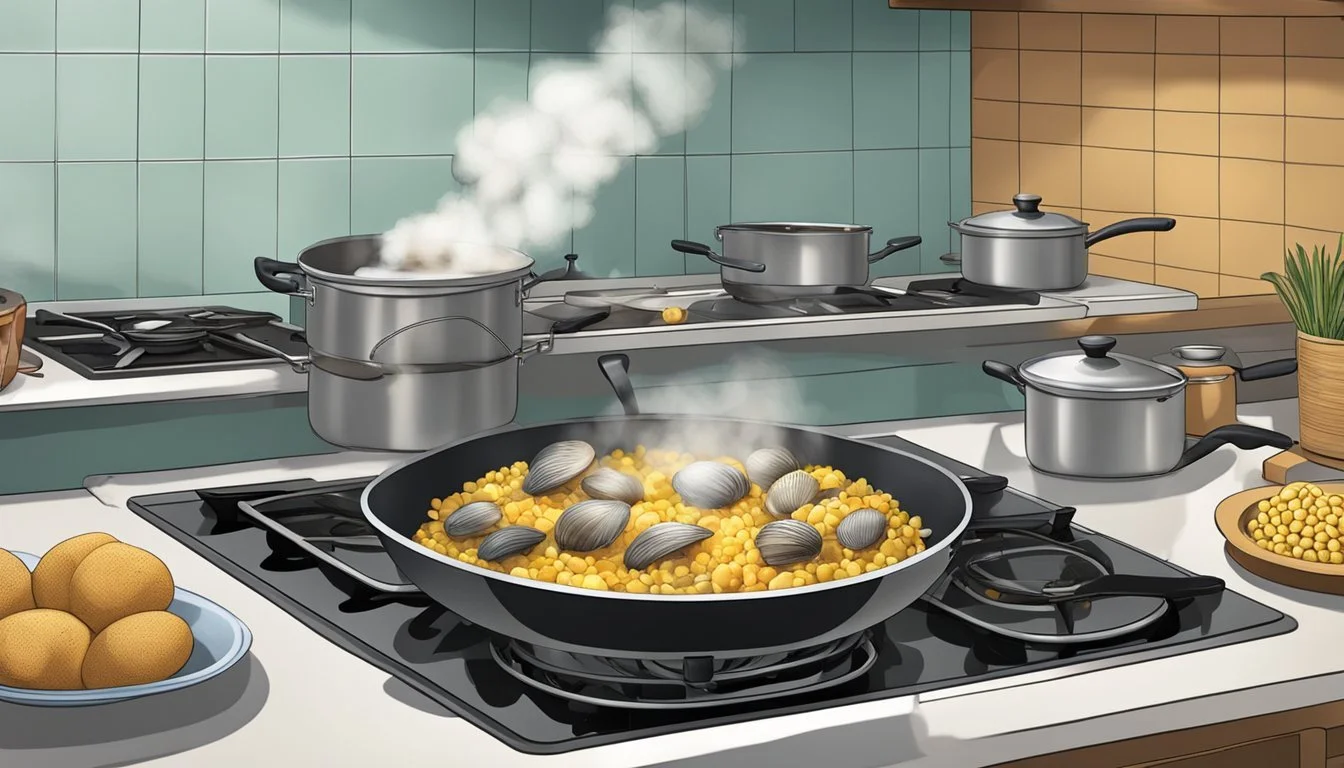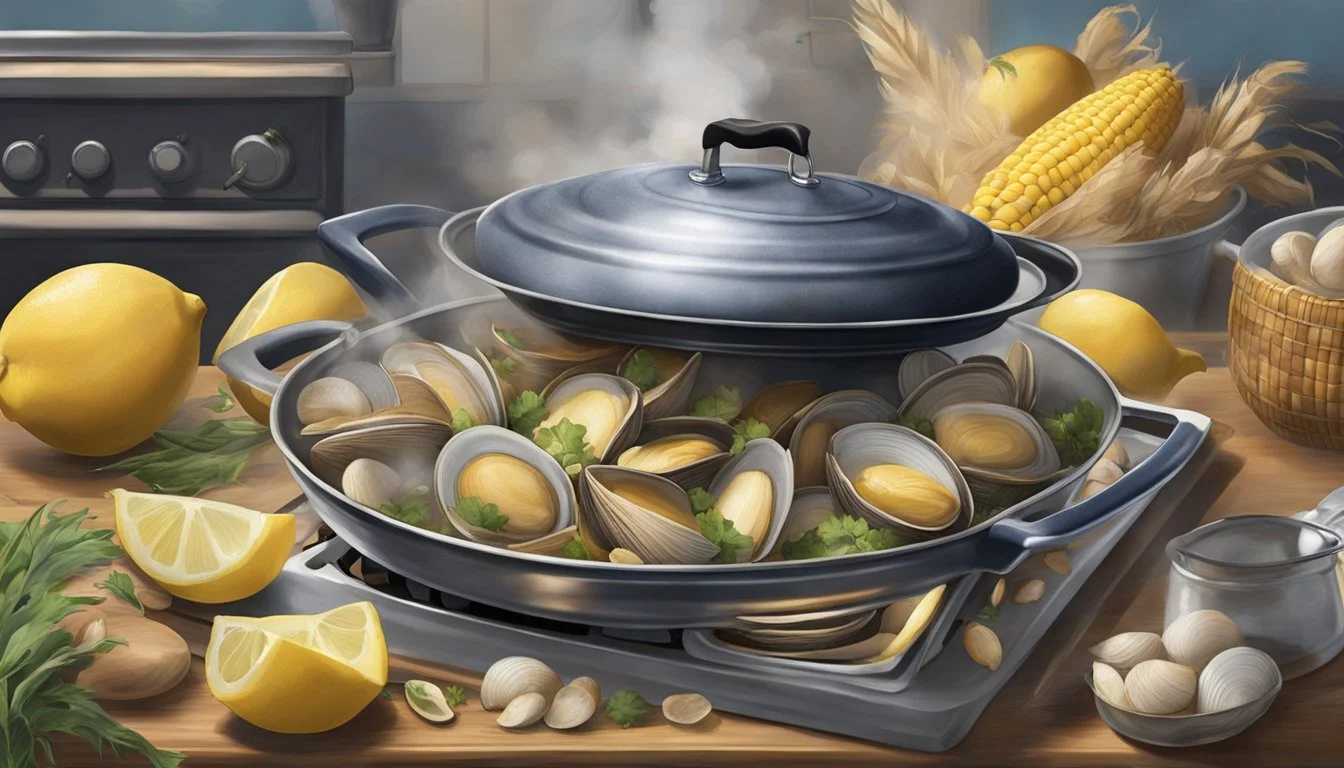The Stovetop Clambake
Effortless Seafood Feast in Your Kitchen
The Stovetop Clambake is a culinary tradition that captures the essence of beachside dining, reimagined for the home kitchen. Originally a feast laid in the sands of the New England coast, the clambake has evolved to accommodate those who wish to recreate the experience without the beach. By bringing the elements of the seaside to the stovetop, this method allows seafood enthusiasts to enjoy a clambake year-round, regardless of proximity to the shore.
Adapting the beach clambake to the stovetop involves careful layering of ingredients and maintaining appropriate heat to steam the seafood (What wine goes well with seafood?) to perfection. Key components like clams, (What wine goes well with clams?) potatoes, corn, and often lobsters (What wine goes well with lobster?) or sausages, are steamed together, melding their flavors. Contrary to the expansive sand pits and seaweed of the traditional method, the stovetop clambake is contained within a single large pot, making it an accessible and straightforward process for most home cooks.
This indoor interpretation honors the communal spirit and the delectable results of its outdoor counterpart. It requires no special equipment beyond a large pot with a tight-fitting lid, ensuring the steam cooks all ingredients thoroughly. Whether nestled in a bustling city apartment or a cozy country home, the stovetop clambake brings the joy and simplicity of beachside cooking into kitchens everywhere, without the sand.
Essentials of Stovetop Clambake
A stovetop clambake captures the essence of the beachside tradition in the comfort of home kitchens. This method is a streamlined process not requiring sand or open flames yet still yielding the sumptuous seafood flavors associated with classic clambakes.
Understanding the Stovetop Method
The stovetop method is an indoor adaptation of the traditional clambake. Cooks layer seafood with vegetables and seasonings in a large pot, and steam it all together. Step-by-step photos can guide first-timers through the process, ensuring each layer is timed correctly to achieve the ideal doneness.
Selecting the Right Equipment
Stockpot: A large stockpot with a lid is essential, a 16 to 20-quart pot is a good size. It must be large enough to hold all ingredients and allow steam to circulate.
Steamer Basket: If available, a steamer basket helps in keeping the seafood elevated above the liquid, making it easier to remove items once cooked.
Ingredients Overview
When preparing a stovetop clambake, the right mix of ingredients and seasonings is key.
Seafood: Lobster, clams, mussels, and optional extras like shrimp.
Vegetables: Potatoes, corn on the cob, and onions are traditional.
Seasonings: Old Bay seasoning and sea salt are classic picks for authentic flavor.
Liquids for Steaming: Water, white wine, or beer can be used.
Aromatics: Garlic, bay leaves, and fresh herbs like thyme enhance the broth.
By following this guide, enthusiasts can enjoy a New England tradition right on their stovetop, without the need for a beach or a fire pit.
Preparation Steps
A successful stovetop clambake hinges upon meticulous preparation of the shellfish (What wine goes well with shellfish?) and careful layering of the ingredients for optimal cooking. Each step is designed to ensure the flavors meld perfectly and the seafood is cooked just right.
Cleaning and Preparing Shellfish
Properly cleaned shellfish are paramount to the quality of your clambake. They should be thoroughly scrubbed under cold water to remove any sand or debris. For the clams, immersing them in cold, salted water for an hour allows them to expel any internal grit.
How to handle shellfish:
Clams: Rinse and soak in saltwater; scrub the shells clean.
Other shellfish: Ensure removal of any beards or byssal threads, and rinse well.
Layering the Ingredients
Strategic layering is integral to a well-executed clambake. Start with a base of aromatic vegetables like fennel, celery, and leeks to infuse the broth with flavor. Add seasonings such as garlic and fresh herbs before introducing the liquid mixture of white wine and water, which will create the steam.
Order of layering:
Aromatics and seasonings
Liquid (white wine and water)
Shellfish: Add lobsters first, followed by the scrubbed clams and other shellfish.
Cooking Time and Temperature
Controlling the cooking time and temperature is crucial for tender, not rubbery, shellfish. Once the liquid comes to a rolling boil, reduce to medium heat. The cooking should be closely monitored—usually, lobsters take around 12-15 minutes; clams follow, taking 5-10 minutes to open.
Cooking guidelines:
Lobsters: ~12-15 minutes on medium heat.
Clams: Add after lobsters, cook until they open (5-10 minutes).
Remember, the shellfish is ready when the clams open and the lobster's shell is a bright red. Timing may vary based on the size and quantity of the shellfish, so observation is key.
Classic New England Ingredients
The essence of a New England clambake is sourced from both land and sea, intertwining fresh produce, aromatic seasonings, and a selection of the region's finest seafood to create a culinary experience that's true to its roots.
Choosing Fresh Produce
In a New England clambake, fresh produce serves as the cornerstone. Corn and potatoes are fundamental, with ears of corn typically left in the husk and potatoes chosen for their ability to hold up well when boiled. Selection criteria for these vegetables hinge on freshness and locality, underscoring the importance of seasonality for optimum flavor and texture.
Corn: Look for bright green husks and plump, juicy kernels.
Potatoes: Choose small to medium-sized red or new potatoes for their firm texture after cooking.
The Role of Seasonings and Spices
While the fresh produce and seafood bring natural flavors to the clambake, strategic use of seasonings and spices is paramount. Traditional New England clambake recipes call for sea salt and peppercorns to enhance the briny taste of the sea, while bay leaves and garlic infuse the broth with depth and aroma. For those who favor a bit of heat, paprika or cayenne pepper can offer a subtle kick.
Sea salt: A generous sprinkle mimics the ocean's salinity.
Bay leaves: One or two leaves add a subtle layer of flavor.
Garlic: Crushed or chopped, garlic imparts a pungent undertone.
Selecting Seafood Varieties
The stars of the clambake are undoubtedly the seafood selections. Clams, lobsters, and occasionally mussels represent the ocean's bounty and are pivotal for an authentic taste of New England. The seafood must be fresh, often alive and sourced locally whenever possible, to preserve the integrity and freshness of the dish.
Clams: Soft-shell clams, or "steamers," are the traditional choice.
Lobsters: Fresh, live lobsters are preferred for their sweetness and tender meat.
Mussels: While not always included, they can complement the clambake with their own unique flavor.
Enriching the Flavor
Enhancing the taste of a stovetop clambake is essential for achieving that authentic beach flair. Incorporating elements like rich fats, wines, and aromatic herbs can elevate the overall dining experience.
Butter and Fats
Butter remains a classic choice for enriching flavor. Unsalted butter is preferred as it allows the chef to control the dish's salinity. Some may opt for melted butter as a dipping sauce, amplifying the moisture and taste of the seafood. Olive oil also serves as a healthy alternative, adding a subtle, fruity undertone that complements the clambake ingredients.
Preferred Fats:
Unsalted butter
Olive oil
Incorporating Wine
A splash of white wine can vastly improve the complexity of the dish's flavor profile. A dry white wine works best, lending an acidic note that balances the brininess of the seafood. Add the wine to the boiling water before layering in the ingredients, ensuring the wine's essence is well integrated.
Wine Selection:
Dry white wine
Aromatics and Herbs
Aromatics like garlic, onion, and bay leaves infuse the steam with fragrances that deeply penetrate the seafood. Adding thyme can introduce a subtle earthiness. For a zesty kick, one can use lemons. Either squeeze fresh lemon juice into the pot or steam with lemon wedges to impart a bright, citrusy flavor.
Aromatics and Herbs:
Garlic (crushed or minced)
Onion (sliced or quartered)
Bay leaves
Thyme
Lemons (cut into wedges)
Serving and Presentation
Presenting a stovetop clambake effectively captures the essence of ocean-side feasts while adapting to an indoor setting. Achieving the right balance of hearty portions, complementary sides, and visual appeal turns the meal into an experience.
Appropriate Serving Sizes
For a stovetop clambake, one should allocate approximately 1 1/2 pounds of mixed seafood per person. This typically includes a combination of clams, shrimp, and any other preferred shellfish. An essential addition to every plate is corn on the cob, typically half an ear per person when cut, ensuring a vibrant and balanced serving.
Accompaniments and Sides
A successful clambake is more than just seafood; the sides are crucial. Each serving should be accompanied by:
Crusty bread, perfect for soaking up the flavorful broth.
Lemon wedges to squeeze on the seafood, enhancing its natural flavors.
A side of fresh corn, adding a sweet crunch that contrasts with the tenderness of the seafood.
Servers should have napkins readily available due to the hands-on nature of the meal.
Presentation Tips
The art of presentation plays a significant role in a stovetop clambake. Here are a few tips to keep in mind:
Use a large platter to display the array of seafood and sides, creating a central, communal dining experience.
Strategically place lemon wedges and fresh herbs across the platter for an appealing pop of color.
Serve the clam broth in individual bowls or a shared pitcher for guests to pour over their serving, ensuring that every bite is moist and flavorful.
By emphasizing not just the taste but also the appearance, hosts can turn the dining table into a coastal tableau.
Alternative Ingredients
In the world of stovetop clambakes, flexibility is key for those who wish to tailor the feast to their dietary preferences or to simply experiment with new flavors. Below are alternatives for vegetables, seafood, and seasonings that maintain the spirit of a traditional New England-style clambake.
Vegetable Substitutes
Traditional clambakes often feature potatoes and corn as staples, but one can also consider sweet potatoes or yams for a similar hearty texture with a slight sweetness. For a low-carb option, cauliflower florets can play the role potatoes usually occupy.
Alternative Seafood Options
For those seeking variety in their seafood selection or when certain ingredients are not available, there are numerous alternatives. Replace steamed clams with mussels for a similar taste and texture. Instead of the usual lobster, try crab, particularly Dungeness or snow crab (What wine goes well with crab?), which are both excellent for their succulent meat. For meat additions, regional sausages like linguica or chorizo can substitute easily for the smoky flavor that smoked kielbasa imparts, while hot dogs can be a simple, kid-friendly option.
Seasoning Variations
While traditional clambakes stick to Old Bay seasoning, fresh herbs, and maybe a splash of beer, one can mix things up with a range of spices. Consider using a blend of smoked paprika, ground fennel, and coriander for a smoky yet slightly sweet profile. One might also create a spicier clambake with cayenne pepper or a Cajun spice blend to enhance the natural flavors of the seafood.
Nutritional Considerations
When enjoying a stovetop clambake, it's important to consider the nutritional content of the meal, including calorie count, macronutrient distribution, and the presence of dietary fiber and sugars.
Calorie Content
The calorie content of a stovetop clambake can vary widely depending on the ingredients used and portion sizes. A typical serving primarily consists of seafood, which is generally low in calories, paired with hearty vegetables and possibly sausage or other meats which increase the calorie count. For example, clams and lobsters are relatively low in calories, while sausages and butter can substantially add to the total caloric value.
Dietary Fiber and Sugars
A stovetop clambake often includes a variety of vegetables such as potatoes, onions, corn, and fennel, which contribute valuable dietary fiber to the meal. Fiber supports healthy digestion and can help maintain a feeling of fullness. These vegetables are also natural sources of sugars, but they do not significantly raise the overall sugar content of the dish as they contain it in modest amounts.
Protein and Fat Breakdown
Seafood, the centerpiece of a clambake, is an excellent source of lean protein and has a low saturated fat content. Clams, for instance, provide protein while containing minimal fat. Lobster adds protein and also some cholesterol. If sausage or butter is included, these will contribute to the fat content — particularly saturated fat. It's advisable to monitor the type and amount of added fats to manage the dish's total fat and cholesterol levels.
Protein: Seafood contains high-quality protein necessary for muscle repair and growth.
Fat: Seafood generally provides healthy fats, like omega-3 fatty acids, with lower levels of saturated fat, unless additional fatty ingredients are introduced.
All ingredients should be considered to manage the intake of sodium, cholesterol, and carbohydrates effectively.
Customizing Your Clambake
A stovetop clambake is a festive and customizable feast, easily adapted for various themes, group sizes, and cooking preferences. By adjusting ingredients and quantities, one can recreate the essence of summer and the seashore experience right in their kitchen.
Themed Variations
Cultural Twists: Incorporate ingredients that nod to different cuisines. Add chorizo for a Spanish influence or lemongrass and ginger for an Asian flair. Swapping traditional elements with unique spices and herbs can transform the clambake into a global experience.
Seasonal Selections: Embrace the spirit of summer by including fresh, seasonal produce. Sweet corn and new potatoes are classic, but one can introduce asparagus in spring or squash in fall for a seasonal twist.
Scaling for Larger Gatherings
Ingredient Ratios: Maintain the balance of the dish when increasing portion sizes. Use a ratio table to ensure that the variety of seafood, vegetables, and seasonings scales up accurately.
Ingredients Small Group (4 ppl) Large Group (12 ppl) Clams 2 lbs 6 lbs Lobsters 2 small 6 small Corn 4 ears 12 ears
Cooking Equipment: For larger groups, one might require an oversized pot to accommodate the increased volume of ingredients. Ensure the pot and heat source can effectively distribute heat for even cooking of all components.
Making It a One-Pot Feast
Streamlining the Process: The appeal of a one-pot clambake lies in its simplicity. Layer ingredients in stages with those requiring more cooking time at the bottom, such as potatoes, and more delicate items, like clams, on top.
Use of Seaweed: Incorporate seaweed not only for its briny flavor but also to create a natural steamy pocket for cooking. It provides moisture and infuses a subtle ocean essence reminiscent of a beach fire clambake.
By personalizing your stovetop clambake through themed variations, adjusting for your number of guests, and ensuring it remains a simple one-pot affair, the tradition becomes a tailored and effortless celebration of coastal cuisine.
Safety and Freshness
Ensuring the safety and freshness of shellfish is paramount when preparing a stovetop clambake. Utilizing fresh ingredients not only ensures optimal flavor but also reduces the risk of foodborne illness.
Identifying Live vs Dead Shellfish
When selecting clams for a stovetop clambake, it's essential to know how to distinguish between live and dead shellfish. Live clams will generally close their shells when tapped—if they don't, they should be discarded. The primary types of clams used—steamer clams, littleneck clams, and cherrystone clams—should all show this response. A dead clam, indicated by a shell that remains open when tapped or that has an odd smell, could harbor bacteria that are harmful if consumed.
Storage and Freshness Tips
Proper storage is crucial to maintain the quality and safety of clams before cooking. Here are tips specific to keeping clams alive and fresh:
Temperature: Store clams in the refrigerator at a temperature between 32°F and 45°F.
Environment: Place clams in a breathable container, such as a mesh bag, covered with a damp cloth to mimic their natural moist environment.
Storage Duration: Clams should be cooked within two days of purchase for utmost freshness.
For vegetables like red potatoes and baby new potatoes, storage in a cool, dry place away from direct sunlight is recommended. Potatoes are best used within a few weeks of purchase to ensure they remain firm and free of sprouts or soft spots.










